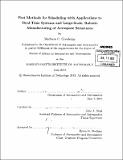| dc.contributor.advisor | Julie A. Shah. | en_US |
| dc.contributor.author | Gombolay, Matthew C. (Matthew Craig) | en_US |
| dc.contributor.other | Massachusetts Institute of Technology. Department of Aeronautics and Astronautics. | en_US |
| dc.date.accessioned | 2014-01-23T18:38:57Z | |
| dc.date.available | 2014-01-23T18:38:57Z | |
| dc.date.issued | 2013 | en_US |
| dc.identifier.uri | http://hdl.handle.net/1721.1/84363 | |
| dc.description | Thesis (S.M.)--Massachusetts Institute of Technology, Dept. of Aeronautics and Astronautics, 2013. | en_US |
| dc.description | Cataloged from PDF version of thesis. | en_US |
| dc.description | Includes bibliographical references (pages 113-117). | en_US |
| dc.description.abstract | Across the aerospace and automotive manufacturing industries, there is a push to remove the cage around large, industrial robots and integrate right-sized, safe versions into the human labor force. By integrating robots into the labor force, humans can be freed to focus on value-added tasks (e.g. dexterous assembly) while the robots perform the non-value-added tasks (e.g. fetching parts). For this integration to be successful, the robots need to ability to reschedule their tasks online in response to unanticipated changes in the parameters of the manufacturing process. The problem of task allocation and scheduling is NP-Hard. To achieve good scalability characteristics, prior approaches to autonomous task allocation and scheduling use decomposition and distributed techniques. These methods work well for domains such as UAV scheduling when the temporospatial constraints can be decoupled or when low network bandwidth makes inter-agent communication difficult. However, the advantages of these methods are mitigated in the factory setting where the temporospatial constraints are tightly inter-coupled from the humans and robots working in close proximity and where there is sufficient network bandwidth. In this thesis, I present a system, called Tercio, that solves large-scale scheduling problems by combining mixed-integer linear programming to perform the agent allocation and a real-time scheduling simulation to sequence the task set. Tercio generates near optimal schedules for 10 agents and 500 work packages in less than 20 seconds on average and has been demonstrated in a multi-robot hardware test bed. My primary technical contributions are fast, near-optimal, real-time systems methods for scheduling and testing the schedulability of task sets. I also present a pilot study that investigates what level of control the Tercio should give human workers over their robotic teammates to maximize system efficiency and human satisfaction. | en_US |
| dc.description.statementofresponsibility | by Matthew C. Gombolay. | en_US |
| dc.format.extent | 117 pages | en_US |
| dc.language.iso | eng | en_US |
| dc.publisher | Massachusetts Institute of Technology | en_US |
| dc.rights | M.I.T. theses are protected by
copyright. They may be viewed from this source for any purpose, but
reproduction or distribution in any format is prohibited without written
permission. See provided URL for inquiries about permission. | en_US |
| dc.rights.uri | http://dspace.mit.edu/handle/1721.1/7582 | en_US |
| dc.subject | Aeronautics and Astronautics. | en_US |
| dc.title | Fast methods for scheduling with applications to real-time systems and large-scale, robotic manufacturing of aerospace structures | en_US |
| dc.type | Thesis | en_US |
| dc.description.degree | S.M. | en_US |
| dc.contributor.department | Massachusetts Institute of Technology. Department of Aeronautics and Astronautics | |
| dc.identifier.oclc | 867539103 | en_US |
